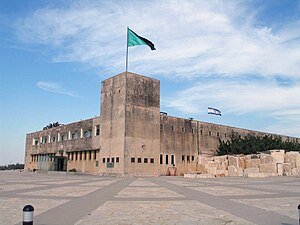Operation Maccabi
| Battles of Latrun | |||||||
|---|---|---|---|---|---|---|---|
| Part of the 1948 Arab–Israeli War | |||||||
 The police fort at Latrun |
|||||||
|
|||||||
| Belligerents | |||||||
|
|
|
||||||
| Commanders and leaders | |||||||
| Sholmo Shamir Mickey Marcus † |
Habis Al-Majali | ||||||
| Strength | |||||||
| 4 brigades (3rd, 7th, 10th, 11th) | Arab Legion 2 brigades (4 Battalions) | ||||||
| Casualties and losses | |||||||
| Bin Nun Alef: 72 KIA, 6 POW, 139–140 WIA Bin Nun Bet: 44 KIA, 88 WIA Operation Yoram: over 16 KIA/79 wounded + 39 KIA/20 injured/13 POW July 16: 23 KIA/numerous injured July 18: 8–12 casualties + 45 KIA of the 11th Total: around 500 (168 KIA, over 327 WIA, 19 POW) for the 5 assaults. |
unknown | ||||||
Decisive Jordanian victory
The Battles of Latrun were a series of military engagements between the Israel Defense Forces and the Jordanian Arab Legion on the outskirts of Latrun between 25 May and 18 July 1948, during the 1948 Arab–Israeli War. Latrun takes its name from the monastery close to the junction of two major highways: Jerusalem to Jaffa/Tel Aviv and Gaza to Ramallah. During the British Mandate it became a Palestine Police base with a Tegart fort. The United Nations Resolution 181 placed this area within the proposed Arab state. In May 1948, it was under the control of the Arab Legion. It commanded the only road linking the Yishuv-controlled area of Jerusalem to Israel, giving Latrun strategic importance in the battle for Jerusalem.
Despite assaulting Latrun on five separate occasions Israel was ultimately unable to capture Latrun, and it remained under Jordanian control until the Six-Day War. The battles were so decisive that the Israelis decided to construct a bypass surrounding Latrun so as to allow vehicular movement between Tel Aviv and Jerusalem, thus avoiding the main road. Regardless, during the Battle for Jerusalem, the Jewish population of Jerusalem could still be supplied by a new road, named the "Burma Road", that bypassed Latrun and was suitable for convoys. The Battle of Latrun left its imprint on the Israeli collective imagination and constitutes part of the "founding myth" of the Jewish State. The attacks cost the lives of 168 Israeli soldiers, but some accounts inflated this number to as many as 2,000. The combat at Latrun also carries a symbolic significance because of the participation of Holocaust survivors.
...
Wikipedia
